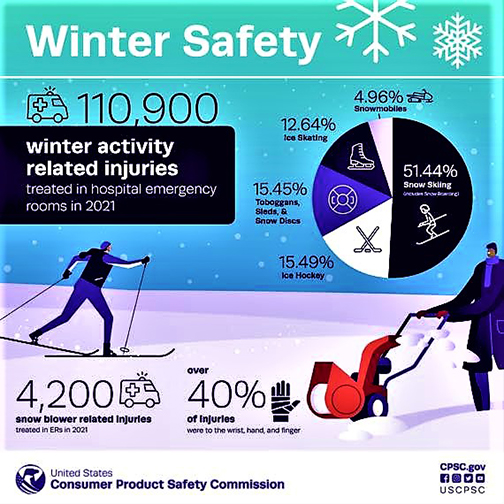WASHINGTON, D.C. – With temperatures dropping as the seasons change, the U.S. Consumer Product Safety Commission (CPSC) is reminding consumers to remain vigilant about safety to avoid tragedies around outdoor activities from sledding and skating to skiing and snow blowing this winter.

In 2021, there were an estimated 110,900 winter activity-related injuries treated in emergency rooms nationwide according to CPSC’s National Electronic Injury Surveillance System (NEISS). The activities included snow skiing, ice hockey, using toboggans, sleds and snow discs, ice skating and using snowmobiles. In 2021, there were over 4,200 snow blower related injuries treated in the ER with over 40 percent of those injuries to the wrist, hand, and finger.
Follow CPSC’s safety tips below to help keep safe:
Winter Sports Safety – Helmets Make a Difference
Wear a properly fitted helmet to reduce the risk of a head injury.
Wear the right helmet for the activity. Check out our helmet safety publication Which Helmet for Which Activity for more information.
Helmets aren’t just for kids — they’re for adults, too.
Snow Blower Hazards – Clear Snow Safely
NEVER leave a gas-powered snow blower running in an enclosed area. The exhaust contains poisonous carbon monoxide, which can kill in minutes.
Don’t add gasoline to a running or hot engine, to avoid a fire; and always keep the gasoline in a portable gasoline container with a child-resistant closure to prevent child poisonings.
Turn the machine off and use a cleanout tool or a long stick, NOT your hands, to unclog wet snow and debris from the machine.
Check for Recalls
Check your home before bringing out winter-related products, check if your products were previously recalled.
Fill out and send in registration cards that come with new products or register your product on the firm’s website so that companies know how to contact you if there is a recall.
Report any unsafe products or any incidents where someone was injured by a product to CPSC at SaferProducts.gov.

